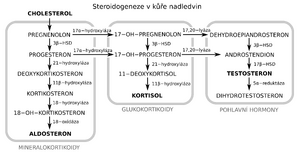Mineralocorticoid
Mineralocorticoids belong to the hormones of the adrenal cortex , which are derivatives of cholesterol , therefore they contain a cyclopentaneoperhydrophenanthrene core. Together with glucocorticoids , they form group C 21 steroids. All secreted C 21 steroids have both mineralocorticoid and glucocorticoid activity. In the case of mineralocorticoids, the effect on the excretion of Na + and K + prevails, in the case of glucocorticoids, the effect on the metabolism of glucose and proteins prevails
All C21 steroids have the 4-ene-3-oxo configuration (4-ene = double bond at the 4th carbon, 3-oxo = keto (oxo) group at the 3rd carbon).
The most important representative of mineralocorticoids is aldosterone .
.
Biosynthesis[edit | edit source]
The precursor of all steroids is cholesterol (originating mainly from LDL, minorly from acetate). It is esterified and stored in fat droplets of adrenocortical cells. Cholesterol ester hydrolase' catalyzes the formation of free cholesterol in fat droplets. This is transported to mitochondria, where it is changed to pregnenolone' with the participation of cholesterol desmolase' (cleaves the side chain). It then travels to the smooth endoplasmic reticulum' (HER), where it is partially dehydrogenated to progesterone (using the enzyme 3β- hydroxysteroid dehydrogenase). Hydroxylation of progesterone to deoxycorticosterone also occurs in the HER. It travels back to the mitochondria, where it is hydrolyzed and corticosterone is produced. 18- hydroxycorticosterone is formed from it, which is finally converted into aldosterone. All the latter reactions are catalyzed by the enzyme aldosterone synthase.
Aldosterone[edit | edit source]
It binds to proteins only to a small extent and its half-life is short - about 20 minutes. It is a steroid hormone. Its secreted amount is small, and the total plasma aldosterone level in humans is normally about 0.006 μg/100 ml. A substantial part is converted in the liver to the tetrahydroglucuronide derivative, but part of aldosterone is converted to the 18-glucuronide' in the liver and kidneys. Unlike the metabolites of other hormones, it is converted to free aldosterone (acidolabile conjugate) by hydrolysis at pH 1.0. Less than 1% of secreted aldosterone appears in free form in urine.
Another 5% is an acid-labile conjugate and up to 40% is in the form of tetrahydroglucuronide.
Effects of mineralocorticoids[edit | edit source]
- increasing reabsorption of Na+ from urine, sweat, saliva and digestive juices
- retention of Na+ in the extracellular fluid (ECT) – > expansion of its volume
- in the kidneys it acts primarily on the main cells (P-cells) of the collecting ducts
- increasing the content of K+ and decreasing the content of Na+ in muscle and brain cells
- under the influence of aldosterone, increased amounts of Na+ are exchanged for K+ and H+ – > excreted urine shows increased acidity
Secondary effects of mineralocorticoid excess[edit | edit source]
- loss of K+ and H+ in urine
- at the beginning of Na+ accumulation, but the plasma concentration does not change, since water is also retained with the osmotically active sodium ions
- increasing ECT volume leads to increased blood pressure'
- when ECT expansion reaches a certain limit, Na+ excretion increases despite the constant action of mineralocorticoids = escape phenomenon' - caused by increased secretion of atrial natriuretic peptide (ANP)
- if there is no escape phenomenon (in some diseases), the permanent expansion of ECT leads to swellings'
Stimulation of aldosterone secretion[edit | edit source]
The main factors of regulation are ACTH from the adenohypophysis, renal renin, acting through angiotensin II, and the direct stimulatory effect of increasing the plasma concentration of K+</ sup> on the adrenal cortex.
The main stimuli stimulating the secretion of aldosterone can simultaneously increase the secretion of glucocorticoids.
1. Simultaneously with an increase in the secretion of glucocorticoids
2. Without simultaneous increase in glucocorticoid secretion (selective effect on aldosterone release)
- high intake of potassiumu
- low intake of sodiumu
- constriction of the thoracic section of the inferior vena cava
- upright posture
- secondary hyperaldosteronism
Links[edit | edit source]
Related Articles[edit | edit source]
Source[edit | edit source]
- ws:Mineralokortikoidy
- GANONG, William F. Přehled lékařské fyziologie. 20. edition. Galén, 2005. 890 pp. ISBN 80-7262-311-7.



